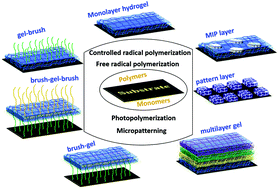Radical polymerization as a versatile tool for surface grafting of thin hydrogel films
Abstract
The surface of solid substrates is the main part that interacts with the environment. Therefore, surface manipulation is a key approach to improve the interaction of solid materials with their surroundings. Grafting of polymeric hydrogels is one of the major strategies for the surface modification of solid substrates. Hydrogels are the most interesting group of soft materials with numerous applications which have been studied extensively over the past few decades. In this review, we discuss the different radical polymerization strategies used for grafting hydrogel layers on the surface of flat substrates. These strategies include the thermal/redox radical polymerizations, controlled radical polymerizations, and photopolymerizations. The main factors in each approach for controlling the properties and architecture of the tethered hydrogel layer are discussed in detail along with representative examples. The soft and hydrophilic nature of the grafted hydrogel layer along with engineering of the hydrogel functional groups endows a variety of properties to the substrates including anti-fouling, anti-fogging, antibacterial, and anti-coagulation.



 Please wait while we load your content...
Please wait while we load your content...